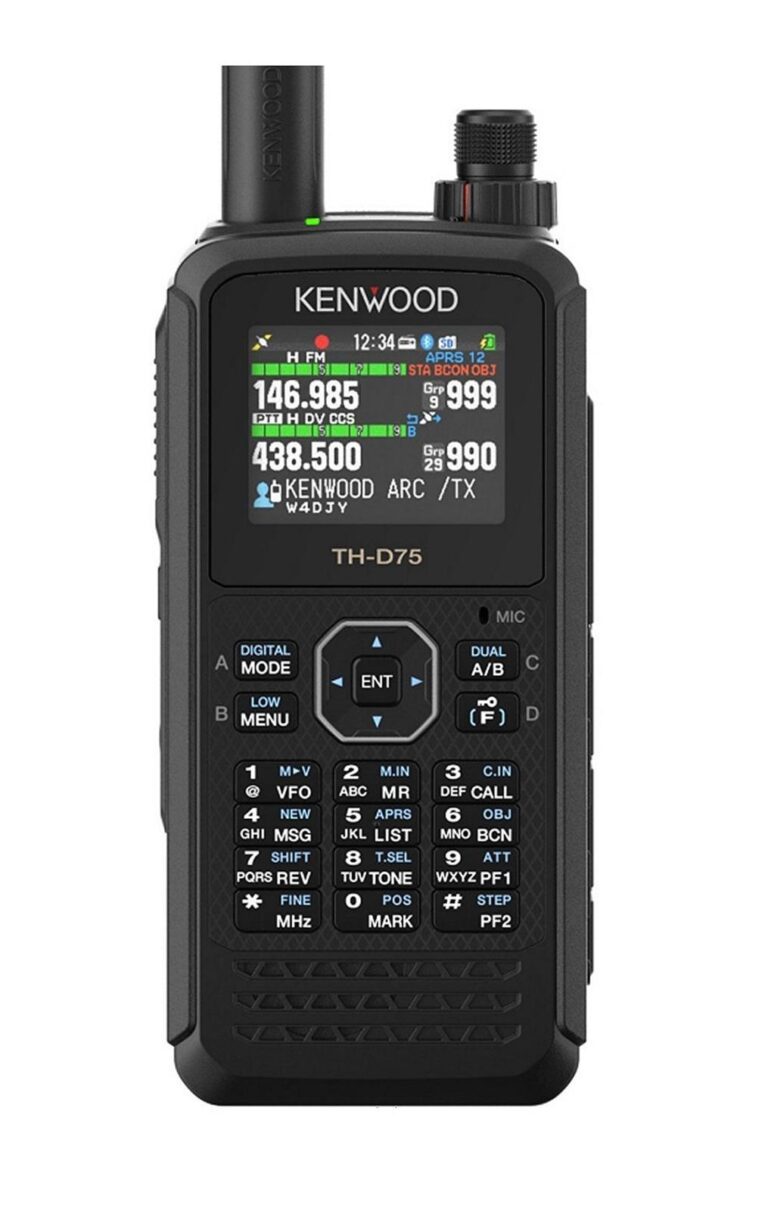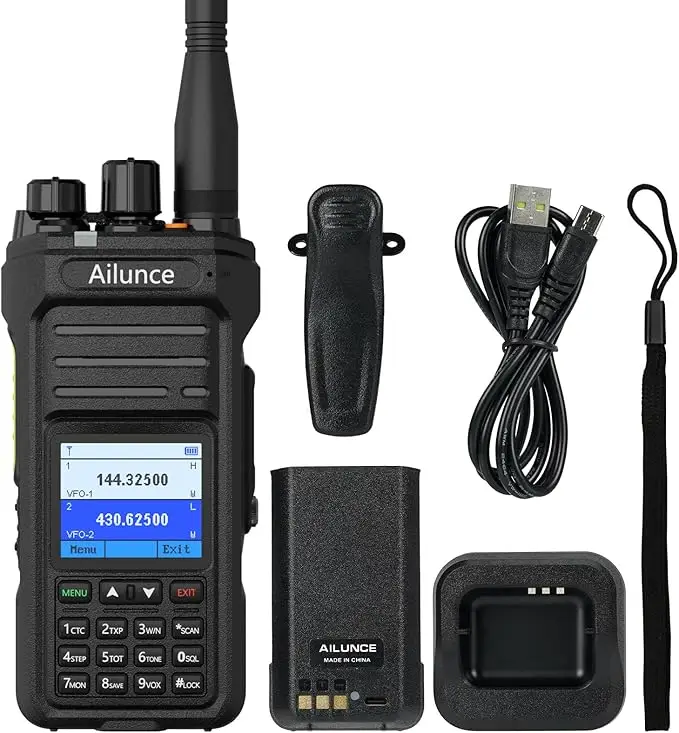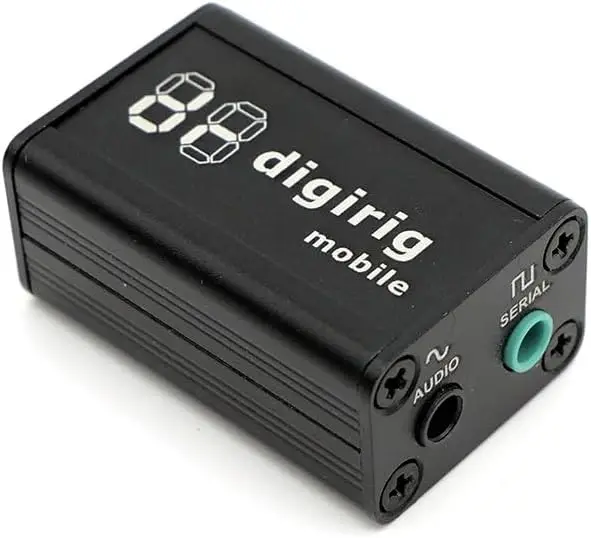If you’ve been keeping tabs on the amateur radio market, you’ve probably noticed Kenwood’s return to the handheld scene after what felt like an eternity. The TH-D75A represents their ambitious attempt to modernize the beloved TH-D74A while addressing the evolving needs of today’s ham radio operators.
Affiliate Disclosure:
“Just so you know, some of the links on this page are affiliate links. This means if you decide to make a purchase through one of those links, I might earn a small commission at no extra cost to you. Your support helps keep this content going—thank you!”
First Impressions and Build Quality
Right out of the box, the TH-D75A feels substantial without being cumbersome. At approximately 370 grams with the standard battery, it’s noticeably lighter than some of the digital behemoths on the market, yet it doesn’t feel fragile. The chassis maintains Kenwood’s reputation for durability with an IP54 rating – not quite submersible, but certainly capable of handling rain and dusty field conditions without breaking a sweat.
The ergonomics strike a pleasant balance. The radio sits comfortably in hand, with controls falling naturally under your fingers. The textured grip areas aren’t just for show; they provide genuine security when operating with gloves or in wet conditions. The belt clip, often an afterthought on handhelds, is robust and confidence-inspiring – you won’t worry about this radio taking an unexpected tumble.
Display and Interface
The color TFT display is where the TH-D75A really starts to show its modern intentions. At 1.54 inches, it’s not massive, but the resolution and clarity make it highly readable even in bright sunlight. The interface allows for multiple display modes, from a simple frequency display to more complex layouts showing APRS data, GPS information, and dual-band monitoring simultaneously.
What impressed me most was the thought put into the menu system. Unlike some radios that feel like they were designed by engineers for engineers, the TH-D75A’s interface feels intuitive. Common functions are accessible through dedicated buttons, while deeper settings are logically organized in the menu structure. The learning curve exists, but it’s manageable even for those transitioning from simpler analog radios.
Performance Specifications
The TH-D75A operates on the traditional 2-meter (144-148 MHz) and 70-centimeter (430-450 MHz) bands, with receive coverage extending from 118-524 MHz (with some gaps). The wide-band receiver makes it useful for monitoring various services beyond amateur radio, though the sensitivity varies considerably outside the ham bands.
Power output is selectable at 5W, 2W, and 0.5W on VHF, with similar options on UHF (5W, 2W, 0.05W). In real-world testing, I consistently measured outputs very close to specifications. The receiver sensitivity, particularly on the amateur bands, is excellent – typically better than 0.15μV for 12dB SINAD.
Battery life with the standard 1800mAh pack is respectable but not exceptional. During mixed use (roughly 60% receive, 30% standby, 10% transmit at 5W), I averaged about 8-10 hours. The optional 3000mAh battery extends this considerably, though it does add bulk and weight.
Digital Capabilities
Here’s where things get interesting. The TH-D75A supports D-STAR, representing Kenwood’s first foray into this particular digital mode. The implementation is solid, with clear digital audio and reliable connectivity to D-STAR repeaters and reflectors. The learning curve for D-STAR newcomers remains steep, but that’s more about the protocol itself than Kenwood’s implementation.
What’s notably absent is DMR or System Fusion compatibility. In an ideal world, we’d have a true multi-mode digital radio, but licensing agreements and technical complexities make this challenging. For operators committed to D-STAR or those lucky enough to have D-STAR infrastructure locally, this won’t be an issue. For others, it might be a dealbreaker.
The built-in APRS functionality remains one of the strongest selling points. With integrated GPS and full APRS messaging capabilities, the TH-D75A excels at position reporting and tactical communications. The implementation feels mature and refined, building on Kenwood’s long history with packet radio.
Bluetooth and Modern Connectivity
The addition of Bluetooth is more than a checkbox feature. It works reliably with a variety of headsets and speakers, and the audio quality is surprisingly good. The Bluetooth programming capability via smartphone app is convenient, though the app itself could use some polish. Still, being able to program repeaters from your phone while standing at a repeater site is undeniably useful.
The USB-C port for charging and programming is a welcome modernization. No more hunting for proprietary cables – any USB-C cable will work for charging, and data transfer uses standard protocols. The radio can even function as a USB sound card for digital modes when connected to a computer.
Real-World Usage
During several weeks of testing, I used the TH-D75A in various scenarios: daily commutes, emergency preparedness exercises, SOTA (Summits on the Air) activations, and casual ragchewing. The audio quality on both transmit and receive is exceptional – that warm, clear Kenwood audio that many operators love.
The dual receive capability works flawlessly, with good isolation between the two receivers. I particularly appreciated being able to monitor a local repeater while tracking APRS activity simultaneously. The spectrum scope, while basic compared to base station radios, provides useful visual feedback about band activity.
One minor frustration involves the antenna connector. While the SMA female connector is standard, it feels like a step backward from the SMA male connectors many manufacturers are adopting. This is a minor quibble, but it does mean most aftermarket antennas will require an adapter.
Value Proposition
At around $650-750 street price, the TH-D75A sits firmly in premium territory. You’re paying for the Kenwood build quality, the refined APRS implementation, D-STAR capability, and modern conveniences like Bluetooth and USB-C. Whether that represents good value depends entirely on your needs and priorities.
For D-STAR users or serious APRS operators, the value proposition is clear. For those primarily interested in analog FM or different digital modes, less expensive options might make more sense. The Yaesu FT-5DR offers System Fusion at a lower price point, while various Chinese manufacturers provide basic dual-band functionality at a fraction of the cost.
Compared to the Competition
Against the Icom ID-52A, the TH-D75A holds its own with superior APRS implementation and arguably better ergonomics, though the Icom offers a larger display and terminal mode access to D-STAR. The Yaesu FT-5DR provides System Fusion capability and excellent water resistance at a lower price, but lacks the refined APRS functionality.
The AnyTone AT-D878UV offers DMR at less than half the price but sacrifices build quality and lacks true APRS capability. Each radio serves its niche, and the “best” choice depends heavily on your local repeater landscape and operating preferences.
Conclusions
The Kenwood TH-D75A is a excellent radio that excels in its intended roles. It’s not trying to be everything to everyone – it’s a premium handheld focused on D-STAR digital voice and APRS data communications, with rock-solid analog performance as a foundation.
The strengths are clear: exceptional build quality, intuitive interface, excellent APRS implementation, reliable D-STAR performance, and modern conveniences that actually improve the user experience. The weaknesses are equally apparent: premium pricing, limited to a single digital mode, and average battery life with the standard pack.
For the right operator – someone invested in D-STAR infrastructure or serious about APRS operations – the TH-D75A represents the current state of the art. It’s a refined, capable tool that will provide years of reliable service. For casual operators or those committed to different digital modes, the value proposition becomes much more questionable.
The amateur radio market desperately needs more radios like the TH-D75A – modern, capable, and pushing the technology forward. While it may not be the perfect radio for everyone, it’s reassuring to see Kenwood back in the game with a serious competitor. The TH-D75A doesn’t revolutionize handheld radios, but it does refine the formula to near perfection within its chosen scope.
Would I recommend it? If you’re in the D-STAR ecosystem or serious about APRS, absolutely. If you’re looking for your first dual-band handheld or need multi-mode digital compatibility, consider your options carefully. The TH-D75A is an excellent radio, but excellence comes at a price – both financial and in terms of digital mode flexibility.
The return of Kenwood to the handheld market with the TH-D75A signals healthy competition in the amateur radio space, and that’s something we can all celebrate, regardless of which radio ends up in our go-bag.



